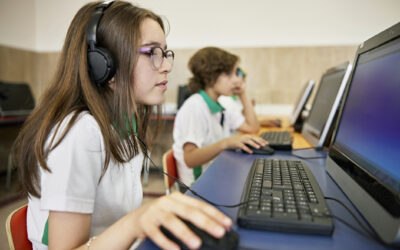From empowering critical thinkers to aligning problem-solving with efficiency and success, algorithmic thinking is a crucial skill for today’s students to learn.
Why is it Important to Teach Algorithmic Thinking to Students?
Algorithmic thinking is important for students because it teaches high-value critical thinking, problem solving and career-ready skills that will benefit them throughout their lives.
Algorithmic is a problem-solving process that, instead of solving for a specific solution, solves for a replicable process to produce a solution not only for a specific problem but for related problems as well. The product, then, isn’t the solution itself, but the process for getting there.
In coding, this is the step where the computer program is conceptualized and laid out. However, in non-computing scenarios, this process of problem solving can play a critical role in long-term success.
Why are algorithmic thinking skills important for students?
1. Strengthens Critical Thinking
One of the main reasons algorithmic thinking is important for students is because it enhances a student’s ability to think critically. It broadens their mind to additional capabilities of a particular solution and helps them see a problem more holistically instead of “mark the right answer on a test” black or white. It also allows them to be more creative with the solution. Instead of reproducing something a teacher has written on the board, the student is drawing from the information they have learned in a variety of environments and can apply that to the development of a unique solution.
2. Develops High-Value Problem Solving Skills
Algorithmic thinking is a critical problem-solving skill for students to learn. It strengthens the ability of the student to create a process for finding a solution as opposed to focusing on the answer itself. In other words, someone a fish and they’ll eat for a day; teach them how to fish and you feed them for a lifetime.
Not only that, but an algorithmic solution is meant to be applied in other scenarios as well. If a student can apply some or all of a previous algorithm to an existing problem, they are able to solve the problem faster, more efficiently, and with more success than if they came up with a solution from scratch every time.
3. Creates the Ability to Develop High-Success Routines
Efficiency creates more opportunities for innovation, increased growth and success. Teaching students to solve problems algorithmically gives them the tools to innovate and grow faster in a variety of environments. For example, a student may create an algorithm for studying that includes rewriting notes in their own words, drawing diagrams or visual aids if appropriate, studying notecards with key facts and questions, and teaching a parent or friend about the subject in detail. Instead of coming up with a new study method every time an exam approaches, the student can use this routine (or an adaptation of this routine) to maximize success. This saves time, reduces trial and error, and creates opportunities for additional learning and development.
In the professional workplace, algorithms make us more efficient. A routine and organizational system to process and reshelve “go-backs” in a retail store means the task can be completed faster and with less effort than processing on an item-by-item basis, opening time for other projects. An optimized landing page formula can be used by a web developer to increase success while decreasing time to production to maximize revenue per hour.
4. Algorithmic Thinking can be Used in Lifelong Application
Finally, algorithmic learning is a skill students can use throughout their lives and in almost any environment. For instance, a parent with algorithmic thinking skills may have a new baby and quickly create internal algorithms to triage cries, including identifying the cry and common physical attributes, then apply the commonly successful routine for soothing the child under that specific circumstance. Couples may discover communication patterns that are successful—or unsuccessful—in their relationship and use the algorithmic information to improve communication during times of conflict.
Final Thoughts
Algorithmic thinking extends far beyond the computer to high-impact problem-solving and critical thinking skills. Learn more about algorithmic thinking in the articles below.
Examples of Algorithmic Thinking
Algorithmic thinking is a derivative of computer science and the process to develop code and program applications.
Definitions of Computational Thinking, Algorithmic Thinking & Design Thinking
While there are differences between each, these methods all blend critical thinking and creativity and follow iterative processes to formulate effective solutions.

Learning.com Team
Staff Writers
Founded in 1999, Learning.com provides educators with solutions to prepare their students with critical digital skills. Our web-based curriculum for grades K-12 engages students as they learn keyboarding, online safety, applied productivity tools, computational thinking, coding and more.
Further Reading
Understanding Proclamation 2024 and the TA-TEKS
Understanding Proclamation 2024 and the TA-TEKS In 2024, Texas introduced Proclamation 2024 to begin the process of adopting new instructional...
Guide to Teaching Algorithms in Computer Programming for K-12 Students
Algorithms are the heart of computer programming, providing the step-by-step instructions that computers follow to perform tasks and solve problems....
Planning Digital Literacy Assessment: A Simplified Approach
As educators know, assessments are critical to the learning process. They provide beneficial self-checks to students, informative results to...






